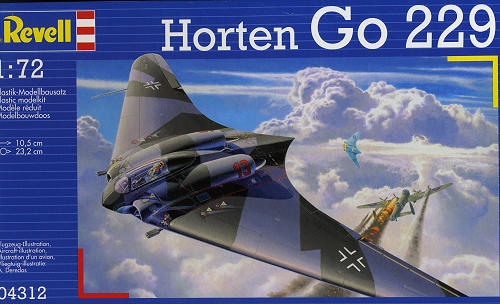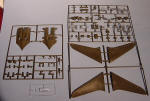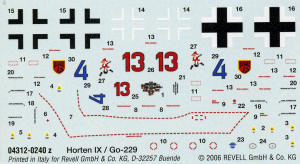
Revell 1/72 Horton Go-229
| KIT #: | 04312 |
| PRICE: | $13.55 at www.greatmodels.com |
| DECALS: | Two options |
| REVIEWER: | Scott Van Aken |
| NOTES: | 2006 boxing |

| HISTORY |
The Horten H.IX, RLM designation Ho 229 (often called Gotha Go 229 due to the identity of the chosen manufacturer of the aircraft) was a late-World War II prototype fighter/bomber designed by Reimar and Walter Horten and built by Gothaer Waggonfabrik. It was the first pure flying wing powered by a jet engine and designed to be more difficult to detect with radar - the first aircraft to incorporate what is now known as stealth technology. It was a personal favorite of German Luftwaffe chief Reichsmarschall Hermann Göring, and was the only aircraft to come close to meeting his "1000, 1000, 1000" performance requirements. Its speed was estimated at 1,024 km/h (636 mph) and its ceiling 15,000 meters (49,213 ft).
| THE KIT |
 This
is a reissue of Revell's fine Go-229 flying wing. The major difference between
this and the initial boxing is a better quality of paper for the instructions,
better and different decals and the kit is now in grey plastic. I pinched the
parts layout image from Olivier Lacombe's earlier preview, hence the brown
plastic.
This
is a reissue of Revell's fine Go-229 flying wing. The major difference between
this and the initial boxing is a better quality of paper for the instructions,
better and different decals and the kit is now in grey plastic. I pinched the
parts layout image from Olivier Lacombe's earlier preview, hence the brown
plastic.
The Go-229 has always fascinated modelers and this is not the first kit of this plane. In 1/48, Dragon did a very nice plastic kit, while in 1/72, PM did a very simple plastic kit. Resin has also been expended on this aircraft by a few companies. But it is the Revell offering that is the best in this smaller scale. The parts show no deterioration in terms of flash, sink areas or other molding glitches. The very small pieces are still finely molded.
Revell's kit offers a full cockpit complete with additional framing. A nice, full color decal is provided for the instrument panel and belts are molded into the seat. Since so much of the fuselage interior is visible, there are several sections of framework that are provided for the wing root area. Twin 30mm cannon and their bays are nicely detailed as well. The kit can be built with the cannon bay doors open; a shame not to display it as such as closing them will hide all this additional detailing.
The wings are built separately and then attached via
strong tabs on the fuselage. Again, one can model this with the wings removed if
one wishes. Considerable space is given to the landing gear. These are somewhat
complex when one adds in the retraction mechanisms, but Revell has done an
excellent job of molding these. If one wants to skip about half the kit parts,
it can be built gear up, but you will have to find a stand for it. There isa two
piece windscreen/canopy so that can be displayed open as well.

Instructions are same as before, but printed on decent paper. Gone is the near newsprint of earlier kits. I do, however, find it a tad irritating that whomever packages the instructions delights in putting the two sheets upside down from each other and folding them in such a way as it makes no sense when opening them. It can be assembled and folded in such a manner as to make it ready to read. Two fictitious markings options are provided, both splinter patterns, One is RLM 74/75/76 and the other is RLM 81/82/76; both with JG 400. Typically, several colors will need to be mixed. The small decal sheet is matte ane well printed in Italy .
| CONCLUSIONS |
Though Luft'46 is not the rage it once was, there are still some excellent kits out there with Revell's being at the tp of the heap in tems of quality.
| REFERENCES |
http://en.wikipedia.org/wiki/Gotha_Go_229
January 2011 You can get this one at GreatModels along with a bunch of other neat stuff. If you would like your product reviewed fairly and quickly, please
contact
me or see other details in the Note to
Contributors.